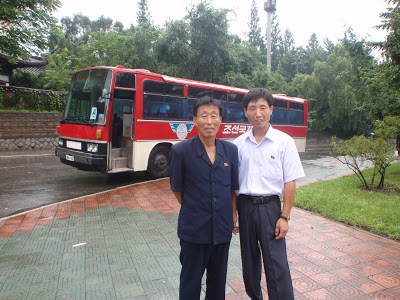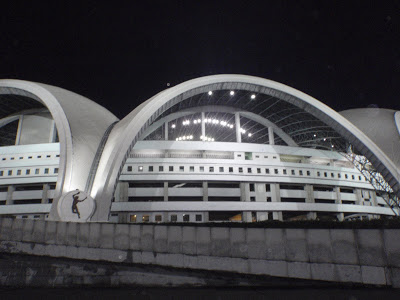Vous pouvez également lire cet article en français.
"Why are you going to North Korea ?"
"Why not ?"
This was an exchange I had frequently before I made my trip to Pyongyang in August. Truth be said, I had an insatiable curiosity about the country on the other side of the DMZ. Books, articles and documentaries had only fuelled my curiosity even more. Knowing that I would have to travel to the DPRK via Beijing I took advantage of being in China over the summer to organise my trip from there.
After attending a briefing at the tour operator's headquarters the day before the trip, the next morning we took a bus to the airport for our Koryo Air flight. My companions were a mixture of Brits, Australians, Irish, German, Dutch, Swiss, Japanese and Americans (yes, Americans are allowed to visit the DPRK !). A short flight on a rather creaky plane with somewhat abrupt hostesses left us the time to peruse the only inflight reading material available: a copy of the weekly English-language "Pyongyang Times" which headlined "Kim Jong Il sees light comedy".
 |
| onboard Koryo Air flight JS252 |
On arrival at Pyongyang, our plane shared the tarmac with that of Jimmy Carter, who was in the country to secure the release of an imprisoned American.
 |
| Arrival at Pyongyang airport |
Security officials checked our luggage before we could leave the airport, and while my copy of "The Woman In White" (written in 1859) passed muster, a friend was told that her copy of "Elle" magazine must absolutely leave the country with her.
On the drive from the airport to our hotel, I was surprised by how green the countryside was, and realised that I had been expecting unalleviated grey everywhere. Our hotel (one of only a handful in Pyongyang where foreigners are allowed to stay) stood on an island in the middle of the Taedong river. We were free to wander around the island but not any further.
 |
| view from our hotel |
However, the next thirty-six hours did not leave us with much time for wandering as we were launched into a whirlwind of sight-seeing. Our first – and symbolically most important – stop was to the Mansudae Grand Monument – the larger than life bronze statue of Kim Il Sung, where we had to lay flowers and bow.
Our next visit was to the Victorious Fatherland Liberation War Museum:
the Triumphal Arch (three metres higher than its French inspiration):
the Tower of the Juche Idea, Kim Il Sung's birthplace:
We even found time to visit a stamp shop and bookshop. New releases advertised at the latter included "Kim Il Sung – the great man of the century" and "On the building of the Worker's Party Of Korea"; I don't know if books on other subjects are available in the DPRK, in any case if they are I never saw them.
We also visited the "USS Pueblo", a US surveillance vessel captured by the North Koreans in 1968:
and Kim Il Sung square – the place probably familiar to you from TV footage of soldiers marching in front of a saluting Kim Jong Il:
We were also given a ride on the Pyongyang Metro:
where, as is the case for all foreign visitors, we were shepherded on at 'Rehabilitation' station:
and alighted one stop later at 'Glory' station:
In the carriage, we travelled under stern photographic portraits of father and son Kim.
The two stations were impressively decorated with chandeliers, marble platforms and vast murals depicting the heroic activities of Kim Il Sung.
While unfortunately we had few chances to talk to ordinary North Koreans, trips between our sights on foot or in our tour bus allowed us glimpses of everyday Pyongyang life.
By the way, the irony of travelling to the DPRK is that most people who go there are independent travellers – the sort of people who never normally take group coach tours, yet that is the only way a foreign visitor can travel in the country! Our group of twenty was flanked at all times by three guides, a cameraman and the bus driver.
Bright propaganda posters occasionally brightened the grey, brutalist architecture of Pyongyang, but the urban colour normally found in shopfronts, plastic bags, billboards and even petrol stations was noticeably missing.
Neither did I see any pets. Most men wore identical charcoal-coloured suits, and women sported mainly plain, unpatterned clothes or hanboks (known in the DPRK as joseonot), some of which were knee-length. And due to the rain, everyone seemed to be wearing wellington boots! I saw more cars than I was expecting, but also long queues at bus stops waiting for crowded buses. However, our guide informed us of the advantages of what was apparently the latest addition to Pyongyang's public transport system – double-decker buses. As there are few traffic lights impeccably-clad baton-wielding traffic ladies directed the traffic at every major intersection with military precision.
Night-time was extremely dark, with few cars, minimum street-lighting and no neon signs. As evening occupations outside of the home are presumably few and far between, I saw that most apartments were lit, but dingily so.
The high point of our stay was probably the chance to see the Mass Games.
Cancelled the first night due to the rain, we were able to attend the following evening. Held in one of the world's largest stadiums:
This highly regimented gymnastic performance emphasizes group dynamics rather than individual skill, and participants number tens of thousands, many more than the audience in fact. The complex and highly choreographed group routines took place in front of a backdrop of card stunts – huge mosaic pictures created by schoolchildren each holding up coloured flip-book cards.
 |
| a scene from the Mass Games |
A trip to the DRPK is on its government's terms and you have no real independence while there. The history you are told is very one-sided or even false (we were told how the USA started the Korean war for example), and total obedience to the state seems to be unquestioned. Internet does not exist and you are not allowed to use the country's currency. At times I felt I was part of a 1950s propaganda movie, or in George Orwell's "1984". But if you are ready to accept these terms you will find yourself visiting a fascinating country like no other on Earth.
This article was originally published in SIWA's "Discovery" magazine (December 2010-January 2011 issue).
If you enjoyed this post you might also like:
- July & August 2010 trip itinerary - Mongolia, China, Tibet
- Steppe-ing Through Mongolia - our trip to Mongolia - this is the most visited post on my blog
- Jolting through the Mongolian steppe - a short video
- China, Part 1 - Beijing, Xian, Xining - the first part of our trip to China
- The Highest Railway in the World - the train journey from Xining to Lhassa
- On The Roof Of The World - our trip to Tibet
- The Tibetan way of working - a short video we filmed at Jokhang temple
- Vladivostok To Moscow : Travelling Across A Quarter Of The Globe by Train - the previous summer (2009) we travelled on the Transsiberian across Russia & Siberia.
Recommended DPRK reading:
- A Corpse in the Koryo (Inspector O Novels), by James Church follows Inspector O, an investigator in North Korea's internal security bureau. Written by a veteran Western intelligence official.
- The Aquariums of Pyongyang by Kang Chol-Hwan and Pierre Rigoulot an account of Kang's 10-year imprisonment in a North Korean concentration camp.
- Nothing to Envy: Ordinary Lives in North Korea by Barbara Demick is a look at the daily lives of six defectors before they left North Korea.
- Pyongyang: A Journey in North Korea by Guy Delisle is a graphic novel documenting the two months French-Canadian animator Delisle spent overseeing cartoon production in North Korea.
Other sights included the Victorious Fatherland Liberation War Museum :
See also:
- Frogs in a Well: Literary Life in North Korea - February 9, 2010 article at Publishing Perspectives.
- The Capture of USS Pueblo - Radio 4 Witness Programme about the American spy ship that was captured by North Korean forces in 1968.

























No comments:
Post a Comment